|
First Battle of Fort Fisher, aka Expedition Against Fort Fisher, Homepage
| Fort Fisher Map |
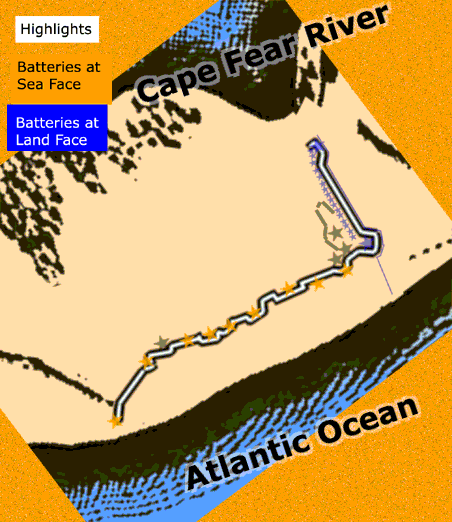
|
| Fort Fisher Defenses |
Introduction
The First Battle of Fort Fisher, also known as the Expedition against Fort
Fisher, fought from December 7 to December 27, 1864, was a failed attempt by
Union forces to capture the fort guarding Wilmington, North Carolina,
the South's last major port on the Atlantic Ocean.
Fort
Fisher : The Southern Gibraltar
"Wilmington was the port into
which the blockade runners were bringing so large a portion of the supplies necessary for the Confederacy that General Lee
said if Fort Fisher fell he could not subsist his army."
Fort Fisher was a Confederate fort during the American
Civil War. It protected the vital trading routes of the port at Wilmington, North
Carolina, from 1861 until its capture by the Union in 1865. The fort was located
on one of Cape Fear River's two outlets to the Atlantic Ocean on what is today known as Pleasure Island. Because of the roughness of
the sea and the Cape Fear River Defenses, it was known as the Southern Gibraltar.
| 1st Battle of Fort Fisher Map |
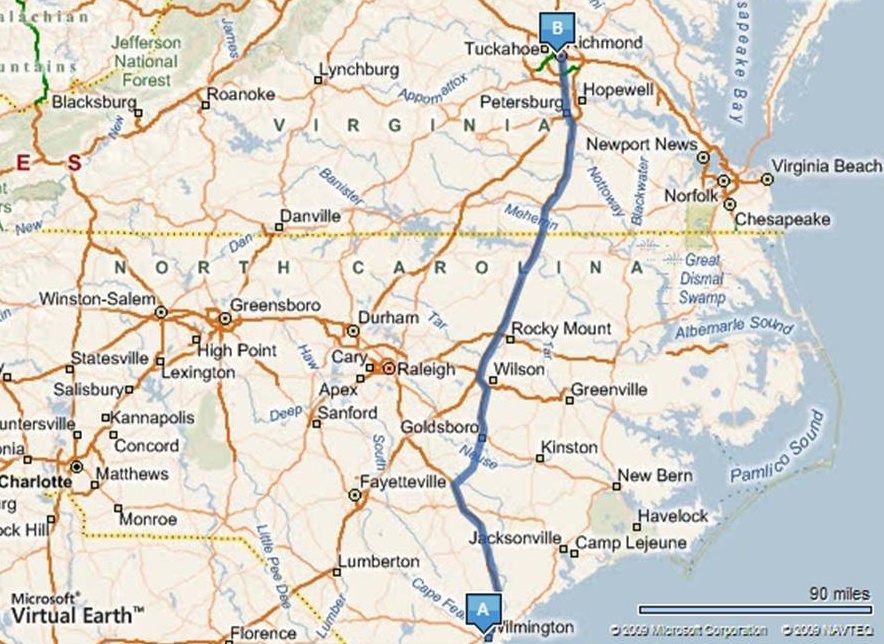
|
| Expedition Against Fort Fisher Map |
Fort Fisher was the stronghold
that protected Wilmington and was considered the lifeline of the Confederacy. Without the formidable Fort Fisher, the
Wilmington and Weldon Railroad that supported Lee's Army of Northern Virginia was vulnerable. While Fort Fisher was under
constant bombardment, Grant, to the north, was engaged in the Siege of Petersburg and its railways.
The Architect of Fort Fisher and the
Caper Fear River Defense System
General William Henry Chase Whiting
(1824-1865), commonly referred to as W.H.C. Whiting, was the top graduate in the class of 1845 at West Point, and he served
brilliantly as an engineer in the United States Army until he resigned his commission and accepted service with the Confederacy
in February 1861. Assigned as commander of the Military District of the Cape Fear, Whiting played a vital role in the construction
of Fort Fisher.
| General W.H.C. Whiting: Historical Marker |
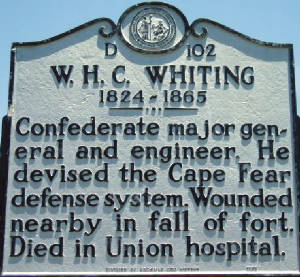
|
| (Architect of the Cape Fear River Defense System) |
Whiting, applying his engineering
skills, designed and developed the most formidable seacoast defense system in the world, the Cape Fear defense system,
which consisted of a series of strategically located forts and batteries along the lower Cape Fear River.
On January 15, 1865, while leading
a countercharge at the fort, he was shot twice in the leg and taken prisoner. General Whiting died as a prisoner on March
10, 1865, of complications from his wounds.
Cape Fear River Defenses: The Cape Fear River Defense System
Located
on the coast near the mouth of the Cape Fear River, Fort Fisher protected blockade-runners as they dashed through the Federal
blockade. Fort Fisher, the largest earthen fort in the world, was essential for the protection of the port of Wilmington.
Work on the fort began soon after North Carolina left the Union, and more than a thousand Confederate soldiers and African
American freedmen and slaves labored together on the construction.
In January 1865, Fort Fisher had twenty-two
cannon facing the Atlantic Ocean, and an additional twenty-five facing the land approach.
| Fort Fisher and Cape Fear Defenses: Map |
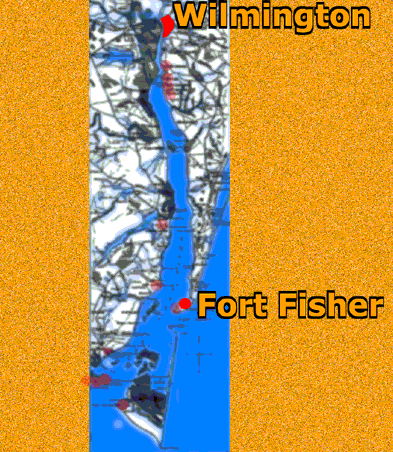
|
| Cape Fear Defense System |
South of Wilmington, along the Cape Fear
River's last 20 miles (30 km), a handful of Confederate forts and batteries protected the daily flow of ships. Also, the channel
had been purposely jammed with loads of wreckage and aquatic mines, which were called "torpedoes." The Confederate officers
conducted and progressed each ship cautiously through this barrier.
Particularly
at Cape Fear's outlet to the Atlantic, the area was enclosed by a half dozen Confederate positions. The river flowed to the
sea through two relatively shallow inlets, which were partitioned by Smith Island. The
existence of two inlets resulted in a crucial advantage: guided by the Confederates, the blockade runners were capable of
avoiding the Union ships. They simply had to change course unexpectedly, alternatively between the two inlets. (Cape Fear River Map and Approaches to Fort Fisher and Wilmington.)
Near the beginning of the war, the Confederacy had occupied the Federal Point
peninsula, which was located at an advantaged location upon Cape Fear's New Inlet. (Cape Fear North Carolina Defenses: American Civil War .)
Fort
Fisher : The Gibraltar of the South
| Fort Fisher: Historical Marker |
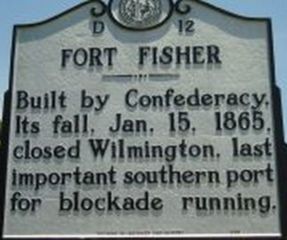
|
| Battle of Fort Fisher |
Fort Fisher, on Confederate Point, nicknamed the "Gibraltar of the Confederacy, and the Gibraltar of the South", was a formidable target commanding the Cape
Fear River. It encompassed 14,500 ft. and was surrounded by a 10-foot parapet and a network of bombproofs,
most of which were 30 feet high. Many obstructions were laid around it, including land mines (also referred to as torpedoes
during the era), abatis, and deep ditches. There were more than 50 heavy cannon, including 15 Columbiads and a 150-pounder
Armstrong gun, behind a 60-foot mound of earth near the sea, named the Mound Battery. The fort's garrison of 1,400 men was
commanded by Colonel William Lamb. Additional reinforcements were available from General Braxton Bragg at Sugar Loaf, 4 miles
away.
The Union naval expedition, the Expedition against
Fort Fisher,
under Rear Admiral David D. Porter comprised the largest fleet of the war, nearly 60 warships plus troop transports for 6,500
soldiers. Learning that the Union troops had embarked from Hampton Roads on December 13, Confederate General Robert E. Lee
dispatched a division under Major General Robert F. Hoke to reinforce Lamb.
Union
Major General Benjamin Butler and his Army of the James were assigned to an amphibious expedition against Fort
Fisher. Lieutenant General Ulysses S. Grant had originally designated
one of Butler's subordinates, Major General Godfrey Weitzel, to lead the expedition, but Butler, the senior major general of volunteers in the Army, demanded
that he lead the troops himself--and Grant acquiesced. Butler did not coordinate the timing
with Porter adequately, however, so that when his troops departed, Confederate reinforcements discouraged further Union attempts.
| Wilmington and Weldon Railroad |
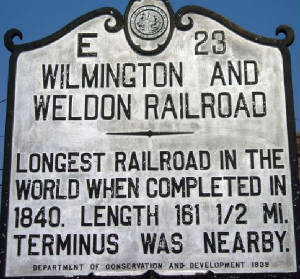
|
| Historical Marker |
Despite explicit
orders from Grant that he was to “besiege the fort if he could not seize it,” Butler
called off the expedition on December 27 and returned to Fort
Monroe. (See Fort Fisher Civil War Battles, by D. H. Hill, Jr.)
The fiasco at Fort
Fisher, specifically Butler's disobedience of his direct orders—orders which Butler failed to communicate either to
Porter or to Weitzel—gave Grant an excuse to relieve Butler, replacing him in command of the Army of the James by Major
General Edward Ord. President Abraham Lincoln, recently reelected, no longer needed to keep the prominent Republican in the
Army and he was relieved on January 8, 1865.
| Civil War Railroads and Battle of Fort Fisher Map |
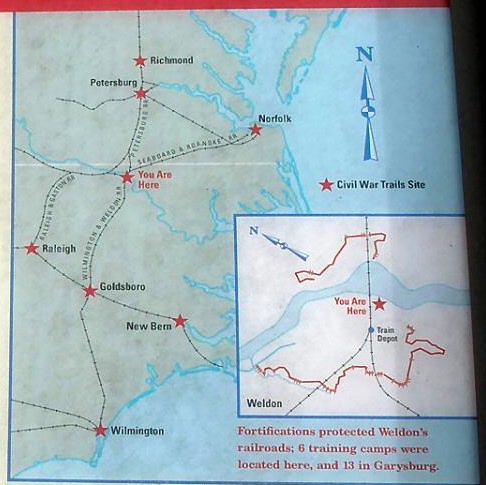
|
| Wilmington & Weldon Railroad and Expedition Against Fort Fisher Map |
| General W.H.C. Whiting |
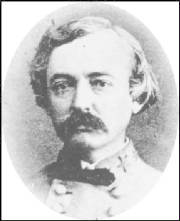
|
| (March 22, 1824 - March 10, 1865) |
Although the initial
Expedition against Fort Fisher had failed, subsequent Operations against Fort Fisher and Wilmington proved to be a Union success. The Federals, with combined naval and land forces during these operations, attacked and
bombarded Fort Fisher into submission and then captured Wilmington, Lee's main supply route to his Army of Northern Virginia. In concert with Grant's Siege of Petersburg, it was now only a matter of months until the Civil War concluded.
Wilmington and Fort Fisher : Gateway to Richmond
Wilmington, North Carolina,
was a major Atlantic Ocean port city for the Confederate States of America during the American Civil War. A vital lifeline
for the fledgling Confederacy to trading partners in Europe, Wilmington was the last major port to fall to the Union Army.
The strategically vital
city of Wilmington
is located 29 miles (50 km) upstream from the mouth of the Cape Fear River, which flows into the Atlantic
Ocean.
During the war, Wilmington was one of the most important points of entry for supplies for the Confederacy.
Its port traded cotton and tobacco in exchange for foreign goods, like munitions, clothing and foodstuffs. This nourished
both the southern states and General Robert E. Lee's forces at Virginia (Wilmington and Weldon Railroad, Fall of Wilmington, and Siege of Petersburg). Trade was based on the "coming and going of steamer ships of British smugglers." These vessels
were called "blockade runners" because they had to avoid the Union's imposed maritime barricade
or blockade (The Union Naval Blockade of Wilmington, North Carolina). Mostly, the blockade runners came indirectly from British colonies, such as Bermuda,
Bahamas, or Nova Scotia.
Often, they were forced to fly the Confederate insignia since the Union had imposed the death
penalty on British "pirates" captured in the region.
| North Carolina Civil War Map of Battles |

|
| (Click to Enlarge) |
After the fall of Norfolk, Virginia, in May 1862, Wilmington
became the main Confederate port on the Atlantic Ocean. Considering the Atlantic seashore,
Wilmington's defenses were so formidable that they were only surpassed by the forts and batteries
in and around Charleston, South Carolina.
Wilmington, for most of the conflict, consequently, remained an open port, mainly because of
Fort Fisher's
presence. (Battle of Wilmington: A History.)
Wilmington
was not captured by Union forces until February 22, 1865, approximately one month after the fall of Fort Fisher. (Wilmington, North Carolina, Civil War History.)
(References listed
at bottom of page.)
Recommended
Reading: Confederate Goliath: The Battle of Fort
Fisher. From Publishers Weekly: Late in the Civil War, Wilmington, N.C.,
was the sole remaining seaport supplying Lee's army at Petersburg, Va., with rations and munitions. In this dramatic account, Gragg describes the two-phase
campaign by which Union forces captured the fort that guarded Wilmington and the subsequent occupation of the city itself--a
victory that virtually doomed the Confederacy. In the initial phase in December 1864, General Ben Butler and Admiral David
Porter directed an unsuccessful amphibious assault against Fort
Fisher that included the war's heaviest artillery bombardment. Continued
below…
The second
try in January '65 brought General Alfred Terry's 9000-man army against 1500 ill-equipped defenders, climaxing in a bloody
hand-to-hand struggle inside the bastion and an overwhelming Union victory. Although historians tend to downplay the event,
it was nevertheless as strategically decisive as the earlier fall of either Vicksburg or Atlanta. Gragg
has done a fine job in restoring this important campaign to public attention. Includes numerous photos.
Expedition against Fort Fisher, aka First Battle of Fort Fisher [December
7-27, 1864]
Recommended Reading: Hurricane
of Fire: The Union Assault on Fort Fisher (Hardcover). Review: In December 1864 and January 1865, Federal
forces launched the greatest amphibious assault the world had yet seen on the Confederate stronghold of Fort
Fisher, near Wilmington, North Carolina. This was the last seaport available to the South--all of the others had
been effectively shut down by the Union's tight naval blockade. The initial attack was a
disaster; Fort Fisher,
built mainly out of beach sand, appeared almost impregnable against a heavy naval bombardment. When troops finally landed,
they were quickly repelled. Continued below…
A second attempt
succeeded and arguably helped deliver one of the death blows to a quickly fading Confederacy. Hurricane of Fire is a work
of original scholarship, ably complementing Rod Gragg's Confederate Goliath, and the first book to take a full account of
the navy's important supporting role in the assault.
Recommended
Reading: The Wilmington Campaign and the Battle for Fort Fisher, by Mark A. Moore. Description:
Full campaign and battle history of the largest combined operation in U.S.
military history prior to World War II. By late 1864, Wilmington
was the last major Confederate blockade-running seaport open to the outside world. The final battle for the port city's protector--Fort Fisher--culminated
in the largest naval bombardment of the American Civil War, and one of the worst hand-to-hand engagements in four years of
bloody fighting. Continued below…
Copious illustrations,
including 54 original maps drawn by the author. Fresh new analysis on the fall of Fort Fisher, with a fascinating comparison
to Russian defenses at Sebastopol during the Crimean War. “A tour de force. Moore's Fort Fisher-Wilmington Campaign is the best publication of this
character that I have seen in more than 50 years.” -- Edwin C. Bearss, Chief Historian Emeritus, National Park Service
Recommended
Reading: The Wilmington Campaign: Last Departing Rays of Hope.
Description: While prior books on the battle to capture Wilmington,
North Carolina, have focused solely on the epic struggles for Fort Fisher, in many respects this was just
the beginning of the campaign. In addition to complete coverage (with significant new information) of both battles for Fort Fisher, "The Wilmington Campaign" includes the first
detailed examination of the attack and defense of Fort Anderson. It also features blow-by-blow accounts of the defense of the Sugar Loaf Line
and of the operations of Federal warships on the Cape Fear River. This masterpiece of military
history proves yet again that there is still much to be learned about the American Civil War. Continued below…
"The Wilmington
Campaign is a splendid achievement. This gripping chronicle of the five-weeks' campaign up the Cape Fear River adds a crucial dimension
to our understanding of the Confederacy's collapse." -James McPherson, Pulitzer Prize-winning author of Battle Cry of Freedom
Recommended
Reading: Rebel Gibraltar: Fort Fisher and Wilmington, C.S.A. Description: Even before the rest of North Carolina joined her sister states in secession,
the people of the Lower Cape Fear were filled with enthusiasm for the Southern Cause - so much so that they actually seized
Forts Johnston and Caswell, at the mouth of the Cape Fear River, weeks before the first shots were fired at Fort Sumter. When
the state finally did secede, Wilmington became the most important port city of the Confederacy, keeping Robert E. Lee
supplied with the munitions and supplies he needed to fight the war against the North. Continued below…
Dedicated soldiers
like William Lamb and W.H.C. Whiting turned the sandy beaches of southern New Hanover and Brunswick Counties into a series
of fortresses that kept the Union
navy at bay for four years. The mighty Fort Fisher
and a series of smaller forts offered safe haven for daring blockade runners that brought in the Confederacy's much-needed
supplies. In the process, they turned the quiet port of Wilmington into a boomtown. In this book that was fifteen years in the making, James
L. Walker, Jr. has chronicled the story of the Lower Cape Fear and the forts and men that guarded it during America's bloodiest conflict, from the early days of the war to the fall of Wilmington in February 1865.
Recommended
Reading: Gray Phantoms of the Cape Fear
: Running the Civil War Blockade. Description:
After the elimination of Charleston in 1863 as a viable entry port for running the blockade,
Wilmington, North Carolina,
became the major source of external supply for the Confederacy during the Civil War. The story of blockade running on the
Cape Fear River was one of the most important factors determining the fate of the South.
With detailed and thought-provoking research, author Dawson Carr takes a comprehensive look at the men, their ships, their
cargoes, and their voyages. Continued below…
In mid-1863,
the small city of Wilmington,
North Carolina, literally found itself facing a difficult
task: it had to supply Robert E. Lee's army if the South was to continue the Civil War. Guns, ammunition, clothing, and food
had to be brought into the Confederacy from Europe, and Wilmington
was the last open port. Knowing this, the Union amassed a formidable blockading force off storied Cape Fear. What followed was a contest unique
in the annals of warfare. The blockade runners went unarmed, lest their crews be tried as pirates if captured. Neither did
the Union fleet wish to sink the runners, as rich prizes were the reward for captured cargoes. The battle was thus one of
wits and stealth more than blood and glory. As the Union naval presence grew stronger, the new breed of blockade runners got
faster, quieter, lower to the water, and altogether more ghostly and their crews more daring and resourceful. Today, the remains
of nearly three dozen runners lie beneath the waters of Cape
Fear, their exact whereabouts known to only a few fishermen and boaters.
Built for a special mission at a brief moment in time, they faded into history after the war. There had never been ships like
the blockade runners, and their kind will never be seen again. Gray Phantoms of the Cape
Fear tells the story of their captains, their crews, their cargoes, their
opponents, and their many unbelievable escapes. Rare photos and maps. “This book is nothing shy of a must read.”
Recommended Reading: Masters of the Shoals: Tales of the
Cape Fear
Pilots Who Ran the Union Blockade. Description:
Lavishly illustrated stories of daring harbor pilots who risked their lives for the Confederacy. Following the Union's blockade of the South's waterways, the survival of the Confederacy depended on a handful of
heroes-daring harbor pilots and ship captains-who would risk their lives and cargo to outrun Union ships and guns. Their tales
of high adventure and master seamanship became legendary. Masters of the Shoals brings to life these brave pilots of Cape Fear who saved
the South from gradual starvation. Continued below…
REVIEWS:
"A valuable and meticulous accounting of one chapter of the South's failing struggle against the Union." -- Washington Times 03/06/04
"An interesting picture of a little appreciated band of professionals...Well documented...an easy read." -- Civil War
News June 2004
"An interesting picture of a little appreciated band of professionals...Will be of special interest to Civil War naval
enthusiasts." -- Civil War News May 2004
"Offers an original view of a vital but little-known aspect of blockade running." -- Military Images 03/01/04
"Surveys the whole history of the hardy seamen who guided ships around the Cape
Fear's treacherous shoals." -- Wilmington
Star-News 10/26/03
"The story [McNeil] writes is as personal as a family memoir, as authoritative and enthusiastic as the best history."
-- The Advocate 11/15/03
“Outstanding and compelling depictions of seamen courage and tenacity...Heroic, stirring, and gripping
stories of the men that dared to confront the might and power of the US Navy.” – americancivilwarhistory.org
References: Rod Gragg, Confederate
Goliath: The Battle of Fort
Fisher (1991); William R. Trotter, Ironclads and Columbiads: The Civil War in North Carolina, Vol. III, The Coast (1989); John G. Barrett, The Civil
War in North Carolina (1963); Ezra J. Warner, Generals in Gray: Lives of the Confederate Commanders (1959); Chris Fonvielle,
Jr., The Wilmington Campaign: Last Rays of Departing Hope (1997); Chris Fonvielle, Jr., Fort Anderson: Battle for Wilmington
(1999); Mark A. Moore, The Wilmington Campaign and the Battles for Fort Fisher (1999); John B. Barrett, The Civil War in North
Carolina (1963); North Carolina Museum of History; NC Office of Archives and History; Library of Congress; National Park Service;
National Archives; D. H. Hill, Jr., Confederate Military History Of North Carolina: North Carolina in the Civil War.
|

